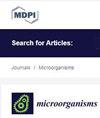通过高通量测序揭示铜矿尾矿中的细菌群落概况
IF 4.1
2区 生物学
Q2 MICROBIOLOGY
引用次数: 0
摘要
矿尾垃圾场是环境恶化的主要来源之一,往往会对公共健康和生态造成影响。由于产生了复杂的生态系统,它们是探索特殊适应微生物细菌多样性的理想场所。我们调查了智利国家铜业公司 Ovejería 尾矿坝固体铜(Cu)矿尾矿中的痕量金属浓度,并利用高通量测序技术,通过基于 16S rRNA 基因的扩增子序列分析,确定了尾矿中微生物群落的多样性。检测到的金属浓度依次为:铁(Fe)>铜(Cu)>锰(Mn)>钼(Mo)>铅(Pb)>铬(Cr)>镉(Cd)。此外,基于 16S rRNA 基因的序列分析确定了三个采样点的 12 个门、18 个类、43 个目、82 个科和 154 个属。蛋白菌门是最主要的门类,其次是衣原体门、类杆菌门、放线菌门和固着菌门。Bradyrhizobium 、Aquabacterium、Paracoccus、Caulobacter、Azospira 和 Neochlamydia 等属的相对丰度较高。众所周知,这些菌属具有对高浓度金属(如镉、铜和铅)的适应机制和固氮能力。除了对各种金属的耐受性外,其中一些菌属还可能是变形虫或人类的病原体,这也是所研究的铜矿尾矿中细菌群落复杂性和复原力的原因之一。这项研究强调了奥韦赫里亚尾矿坝中独特的微生物多样性,包括首次报告发现了耐重金属的 Neochlamydia 属。这凸显了对矿区(尤其是智利的矿区)进行特征描述的重要性,以发现潜在生物技术应用的新型细菌机制。本文章由计算机程序翻译,如有差异,请以英文原文为准。
Profile of Bacterial Communities in Copper Mine Tailings Revealed through High-Throughput Sequencing
Mine-tailing dumps are one of the leading sources of environmental degradation, often with public health and ecological consequences. Due to the complex ecosystems generated, they are ideal sites for exploring the bacterial diversity of specially adapted microorganisms. We investigated the concentrations of trace metals in solid copper (Cu) mine tailings from the Ovejería Tailings Dam of the National Copper Corporation of Chile and used high-throughput sequencing techniques to determine the microbial community diversity of the tailings using 16S rRNA gene-based amplicon sequence analysis. The concentrations of the detected metals were highest in the following order: iron (Fe) > Cu > manganese (Mn) > molybdenum (Mo) > lead (Pb) > chromium (Cr) > cadmium (Cd). Furthermore, 16S rRNA gene-based sequence analysis identified 12 phyla, 18 classes, 43 orders, 82 families, and 154 genera at the three sampling points. The phylum Proteobacteria was the most dominant, followed by Chlamydiota, Bacteroidetes, Actinobacteria, and Firmicutes. Genera, such as Bradyrhizobium, Aquabacterium, Paracoccus, Caulobacter, Azospira, and Neochlamydia, showed high relative abundance. These genera are known to possess adaptation mechanisms in high concentrations of metals, such as Cd, Cu, and Pb, along with nitrogen-fixation capacity. In addition to their tolerance to various metals, some of these genera may represent pathogens of amoeba or humans, which contributes to the complexity and resilience of bacterial communities in the studied Cu mining tailings. This study highlights the unique microbial diversity in the Ovejería Tailings Dam, including the discovery of the genus Neochlamydia, reported for the first time for heavy metal resistance. This underscores the importance of characterizing mining sites, particularly in Chile, to uncover novel bacterial mechanisms for potential biotechnological applications.
求助全文
通过发布文献求助,成功后即可免费获取论文全文。
去求助
来源期刊

Microorganisms
Medicine-Microbiology (medical)
CiteScore
7.40
自引率
6.70%
发文量
2168
审稿时长
20.03 days
期刊介绍:
Microorganisms (ISSN 2076-2607) is an international, peer-reviewed open access journal which provides an advanced forum for studies related to prokaryotic and eukaryotic microorganisms, viruses and prions. It publishes reviews, research papers and communications. Our aim is to encourage scientists to publish their experimental and theoretical results in as much detail as possible. There is no restriction on the length of the papers. The full experimental details must be provided so that the results can be reproduced. Electronic files and software regarding the full details of the calculation or experimental procedure, if unable to be published in a normal way, can be deposited as supplementary electronic material.
 求助内容:
求助内容: 应助结果提醒方式:
应助结果提醒方式:


